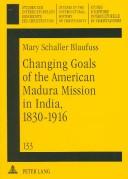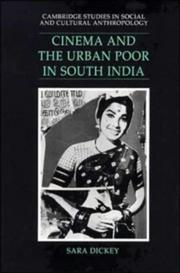| Listing 1 - 10 of 14 | << page >> |
Sort by
|
Book
ISBN: 9782855391397 8184702000 2855391393 9788184702002 Year: 2014 Publisher: Pondichéry: Institut français de Pondichéry,
Abstract | Keywords | Export | Availability | Bookmark
 Loading...
Loading...Choose an application
- Reference Manager
- EndNote
- RefWorks (Direct export to RefWorks)
Papers presented at the workshop-cum-conference on "Archaeology of Bhakti in South India", held at Pondicherry during 1-12 August 2011.
Cults --- Cults --- Mathurā (India) --- Madurai (India) --- Mathurā (India) --- Madurai (India)
Book
Year: 1887 Publisher: Trichinopoly Collège Saint-Joseph
Abstract | Keywords | Export | Availability | Bookmark
 Loading...
Loading...Choose an application
- Reference Manager
- EndNote
- RefWorks (Direct export to RefWorks)
Missions --- Madurai (India --- District) --- Description and travel
Book
Year: 1960 Volume: 19 Publisher: Pondichery : Institut français d'indologie,
Abstract | Keywords | Export | Availability | Bookmark
 Loading...
Loading...Choose an application
- Reference Manager
- EndNote
- RefWorks (Direct export to RefWorks)
Book
Year: 1991 Publisher: Napoli : Istituto universitario orientale,
Abstract | Keywords | Export | Availability | Bookmark
 Loading...
Loading...Choose an application
- Reference Manager
- EndNote
- RefWorks (Direct export to RefWorks)
Fasts and feasts --- Fasts and feasts --- Hinduism --- Hinduism. --- Customs and practices. --- Madurai (India) --- Madurai (India) --- Religious life and customs. --- Social life and customs.
Book
ISBN: 9788173049316 8173049319 Year: 2012 Publisher: New Delhi : Manohar,
Abstract | Keywords | Export | Availability | Bookmark
 Loading...
Loading...Choose an application
- Reference Manager
- EndNote
- RefWorks (Direct export to RefWorks)
"Court journeys represent the most spectacular sub-genre in Western travel literature and the history of cross-cultural interaction. Preceded by an incisive introduction on images and ideologies of Dutch-South Asian contact, these are the hitherto unpublished accounts and related documents of three encounters between representatives of the Dutch East India Company (VOC after its Dutch initials), one of the great northern European chartered companies of the age of mercantilism, and the state of Madurai, one of the 'great southern Nayakas' and successor-states of the Vijayanagara empire, in southeast India in the second half of the seventeenth century. A shared interest in trade and at times converging political objectives formed the unstable foundations for a complex courtship fraught with tensions between two ill-suited partners, a mixture of conflict and coexistence typical of the 'age of contained conflict.'"--Jkt.
Dutch --- History --- Nederlandsche Oost-Indische Compagnie --- Nederlandsche Oost-Indische Compagnie --- History --- Madurai (India) --- India --- Europe --- Madurai (India) --- History --- Sources --- Commerce --- History --- Commerce --- History --- Economic conditions.
Book
ISBN: 1283293455 9786613293459 1605099805 9781605099804 9781605099811 1605099813 9781283293457 9781605099798 1605099791 Year: 2011 Publisher: San Francisco, Calif. : Berrett-Koehler Publishers,
Abstract | Keywords | Export | Availability | Bookmark
 Loading...
Loading...Choose an application
- Reference Manager
- EndNote
- RefWorks (Direct export to RefWorks)
"The Aravind Eye Hospital, based in India, is the world's largest provider of high-quality eye care. It is also one of the world's most incredible and revolutionary organizations - delivering surgical outcomes equal to or exceeding those in the developed world at less than one percent of the cost, treating more than half of its patients free of charge, and taking no grants or donations. Aravind's success is so perplexing it has been the subject of a popular Harvard Business School case study. This is the first book to explore Aravind's history and the distinctive philosophies, practices, and commitments that are the keys to its success. Mehta and Shenoy share incredible stories about how Aravind grew from humble beginnings--founded by a retired ophthalmologist with no money or prior entrepre-neurial experience--to the world-class organization it is today. They explain the mysteries of a model that integrates innovation with empathy, service with business principles, and inner change with outer transformation. And they show how choices that seem foolish and unworkable can, when executed with compassion and integrity, yield powerful results - results that literally light the eyes of millions."--Provided by publisher.
Ophthalmology --- Eye --- Hospitals --- Diseases --- Treatment --- Venkataswamy, Govindappa. --- Aravind Eye Hospital (Madurai, India)
Book
ISBN: 1009174770 1009150162 1009150154 Year: 2023 Publisher: Cambridge : Cambridge University Press,
Abstract | Keywords | Export | Availability | Bookmark
 Loading...
Loading...Choose an application
- Reference Manager
- EndNote
- RefWorks (Direct export to RefWorks)
In this innovative study, Gita V. Pai traces the history of the Pudu Mandapam (Tamil, 'new hall') - a Hindu temple structure in Madurai - through the rise and fall of empires in south India from the seventeenth century to the present. This wide-ranging work illustrates how south Indian temples became entangled in broader conflicts over sovereignty, from early modern Nayaka kings, to British colonial rule, to the post-independence government today. Drawing from methodologies in anthropology, religious studies, and art and architectural history, the author argues that the small temple site provides profound insight into the relationship between aesthetics, sovereignty, and religion in modern South Asia.
Architecture and society. --- Art and society. --- Maturai Aruḷmiku Mīn̲āṭci Cuntarēsvarar Ālayam. --- Pudu Maṇḍapam. --- Art --- Art and sociology --- Society and art --- Sociology and art --- Architecture --- Architecture and sociology --- Society and architecture --- Sociology and architecture --- Social aspects --- Human factors --- New Hall (Madurai, India) --- Puthoo Muntapam --- Minaksi Temple (Madurai, India) --- Madurai, India (City). --- Meenakshi Temple (Madurai, India) --- Madurai (India). --- Sri Meenakshisundareswarar Temple (Madurai, India) --- Meenakshisundareswarar Temple (Madurai, India) --- Mīn̲aṭci Cuntarēsvarar Ālayam (Madurai, India) --- Shri Minakshi Sundareswar Temple (Madurai, India) --- Madurai Temple --- Meenakshi Amman Temple --- Meenakshi Sundareswarar Temple --- Tiru-aalavaai --- Meenakshi Amman Kovil --- Architecture and society --- Art and society --- Political aspects --- Art, Occidental --- Art, Primitive --- Art, Visual --- Art, Western (Western countries) --- Arts, Fine --- Arts, Visual --- Fine arts --- Iconography --- Occidental art --- Visual arts --- Western art (Western countries) --- Arts --- Aesthetics --- Architecture, Primitive --- Architecture, Western (Western countries) --- Building design --- Buildings --- Construction --- Western architecture (Western countries) --- Building --- Design and construction --- LITERARY CRITICISM / European / English, Irish, Scottish, Welsh
Book
ISBN: 9780813583938 0813583934 9780813583945 0813583942 9780813583921 0813583926 9780813583914 0813583918 Year: 2016 Publisher: New Brunswick, NJ : Rutgers University Press,
Abstract | Keywords | Export | Availability | Bookmark
 Loading...
Loading...Choose an application
- Reference Manager
- EndNote
- RefWorks (Direct export to RefWorks)
Many Americans still envision India as rigidly caste-bound, locked in traditions that inhibit social mobility. In reality, class mobility has long been an ideal, and today globalization is radically transforming how India's citizens perceive class. Living Class in Urban India examines a nation in flux, bombarded with media images of middle-class consumers, while navigating the currents of late capitalism and the surges of inequality they can produce. Anthropologist Sara Dickey puts a human face on the issue of class in India, introducing four people who live in the "second-tier" city of Madurai: an auto-rickshaw driver, a graphic designer, a teacher of high-status English, and a domestic worker. Drawing from over thirty years of fieldwork, she considers how class is determined by both subjective perceptions and objective conditions, documenting Madurai residents' palpable day-to-day experiences of class while also tracking their long-term impacts. By analyzing the intertwined symbolic and economic importance of phenomena like wedding ceremonies, religious practices, philanthropy, and loan arrangements, Dickey's study reveals the material consequences of local class identities. Simultaneously, this gracefully written book highlights the poignant drive for dignity in the face of moralizing class stereotypes. Through extensive interviews, Dickey scrutinizes the idioms and commonplaces used by residents to justify class inequality and, occasionally, to subvert it. Along the way, Living Class in Urban India reveals the myriad ways that class status is interpreted and performed, embedded in everything from cell phone usage to religious worship.
Social stratification --- Social classes --- Stratification, Social --- Equality --- Social structure --- Class distinction --- Classes, Social --- Rank --- Caste --- Estates (Social orders) --- Social status --- Class consciousness --- Classism --- Madurai (India) --- Madura (India) --- Madurai, India (City) --- Mathurai (India) --- Maturai (India) --- Economic conditions. --- Social conditions.

ISBN: 363150585X Year: 2003 Volume: 133 Publisher: New York : Peter Lang,
Abstract | Keywords | Export | Availability | Bookmark
 Loading...
Loading...Choose an application
- Reference Manager
- EndNote
- RefWorks (Direct export to RefWorks)
Missions, American --- Missions, American --- Missions americaines --- Madurai (Inde) --- History --- History --- Eglise --- Histoire --- American Madura Mission --- American Madura Mission --- History --- History --- Madurai (India) --- Madurai (India) --- Madurai (Inde) --- Madurai (Inde) --- Church history --- Church history --- Eglise --- Histoire --- Eglise --- Histoire

ISBN: 052144084X 0521055970 0521040078 0511557973 9780521440844 9780511557972 9780521055970 Year: 1993 Volume: 92 Publisher: Cambridge Cambridge University Press
Abstract | Keywords | Export | Availability | Bookmark
 Loading...
Loading...Choose an application
- Reference Manager
- EndNote
- RefWorks (Direct export to RefWorks)
This study of the Indian cinema is concerned particularly with cinema-goers in Madurai, a city in Tamil Nadu, South India. Sara Dickey reviews the history of Tamil film, explains the structure of the industry, and presents the perspective of the filmmakers. However, the core of the book is an analysis of the films themselves and the place they have in the lives of poor people, who organize fan clubs, discuss the films and the actors, and in various ways relate these fantasy worlds to their own lives. Dickey argues that the effect of these films is ultimately conservative, for they glorify poverty while holding out the hope of a better future. Her rich ethnography makes an interesting contribution to the study of film in India and, more generally, to the understanding of popular culture in an Indian city.
Motion pictures --- Urban poor --- Motion picture audiences --- Popular culture --- Social aspects --- Madurai (India) --- Social Sciences --- Anthropology --- Culture, Popular --- Mass culture --- Pop culture --- Popular arts --- Communication --- Intellectual life --- Mass society --- Recreation --- Culture --- Film audiences --- Filmgoers --- Moviegoers --- Moving-picture audiences --- Performing arts --- City dwellers --- Poor --- Cinema --- Feature films --- Films --- Movies --- Moving-pictures --- Audio-visual materials --- Mass media --- Audiences --- History and criticism --- Popular culture. --- Madura (India) --- Madurai, India (City) --- Mathurai (India) --- Maturai (India) --- Motion pictures - Social aspects - India - Tamil Nadu --- Urban poor - India - Tamil Nadu --- Motion picture audiences - India - Madurai --- Popular culture - Madurai (India) --- Madurai (India) - Popular culture
| Listing 1 - 10 of 14 | << page >> |
Sort by
|

 Search
Search Feedback
Feedback About UniCat
About UniCat  Help
Help News
News